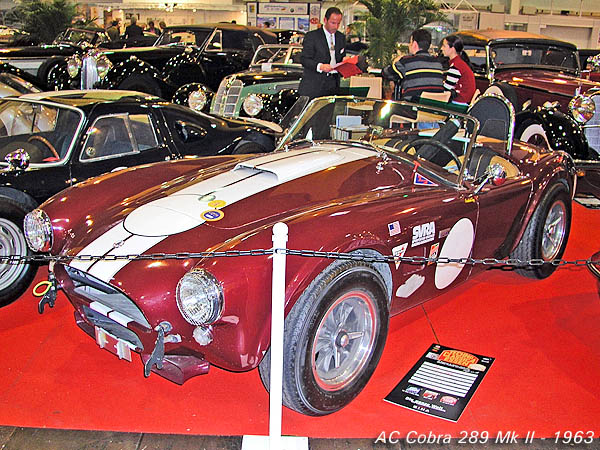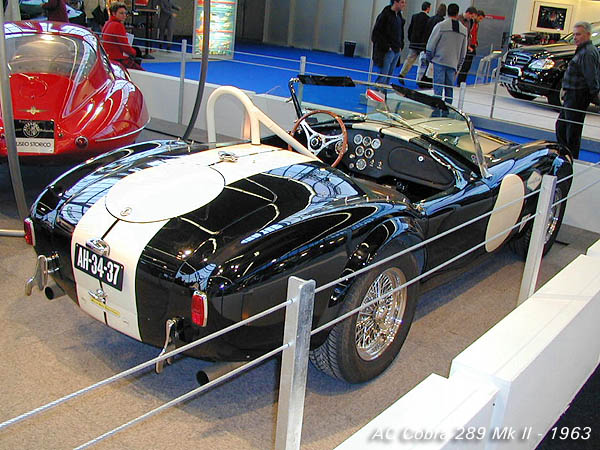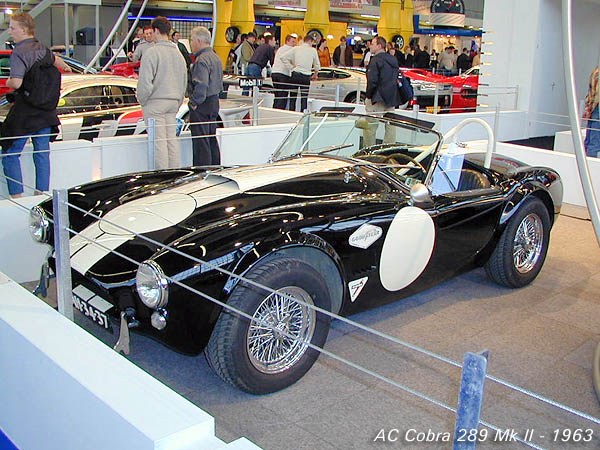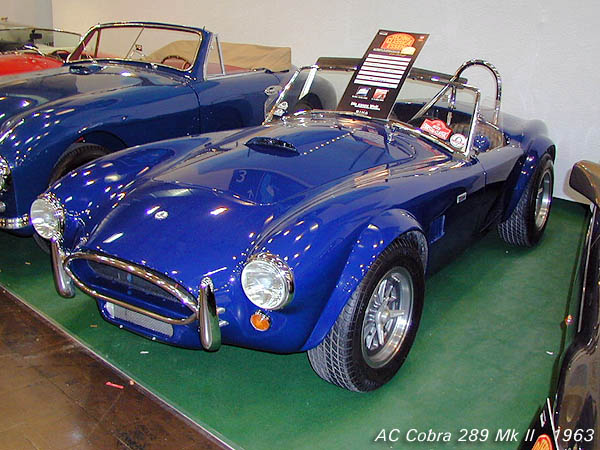|
 Just as the fortunes of the AC Ace were waning rescue came from an unexpected corner. Texan racing driver and entrepreneur Carroll Shelby was forced to stop his active racing career after heart problems in 1960 and now fancied the idea of creating an affordable sports car with European looks and handling and brute American power. The idea itself was not original, it had been done for decades with British examples like the Hudson powered Railton in the 1930s and the Nash powered Healey and Ford powered Allard in the 1950s. In fact, it was a Cadillac V8 propelled Allard J2 which Shelby drove in 1953 that had inspired him. But the way Shelby executed this idea was however unique. Just as the fortunes of the AC Ace were waning rescue came from an unexpected corner. Texan racing driver and entrepreneur Carroll Shelby was forced to stop his active racing career after heart problems in 1960 and now fancied the idea of creating an affordable sports car with European looks and handling and brute American power. The idea itself was not original, it had been done for decades with British examples like the Hudson powered Railton in the 1930s and the Nash powered Healey and Ford powered Allard in the 1950s. In fact, it was a Cadillac V8 propelled Allard J2 which Shelby drove in 1953 that had inspired him. But the way Shelby executed this idea was however unique.
Shelby contacted several British sports car manufacturers with a proposal to built a 100 of these hybrids so that the car could qualify for production sports car racing and generate the necessary publicity. Most of these companies, like Healey, declined for reasons varying between too much investment costs and not liking the idea at all. AC on the other had didn't have these reservations: the hand built Ace didn't need much retooling to adapt it to a different engine and, even more important, AC could do with a fresh impulse for its sports car business.
 So for AC the idea came at the right time. On the other side Shelby found the Ace ideal for his plans as well. It was a car with a racing pedigree which he saw win its class in the 1959 Le Mans race, it was lightweight and pretty and had a sound built quality. That left the matter of the right engine. So for AC the idea came at the right time. On the other side Shelby found the Ace ideal for his plans as well. It was a car with a racing pedigree which he saw win its class in the 1959 Le Mans race, it was lightweight and pretty and had a sound built quality. That left the matter of the right engine.
Problem was that most American cast iron V8 blocks were simply to heavy for a nimble sports car. GM's small alloy 3.5 litre V8 could have been an option, but it was just going out of production at the time due to high manufacturing costs. This engine design later reappeared in the Rover cars and now probably is the most popular power unit to propel Cobra replicas and kit cars. But thanks to his contacts with the Ford factory he learned that they were introducing a new compact V8 for the Fairlane models. It was a 221 cubic inch (3,621 cc) unit produced with the latest casting techniques which meant a reduced weight.
It was perfect for the car Shelby had in mind and even better: Ford was very much interested in his project as they were looking for ways to attract a younger clientele and a new exciting sports car fitted in well with this strategy. Shelby was offered a few lightweight 260 ci (4,260 cc) versions of the Fairlane engine to produce prototypes of his sports car.
 Development of the Shelby car had begun as early as 1961 at AC Cars in Britain. Under supervision of chief engineer designer Alan Turner of AC the chassis was stressed and strengthened to prepare it for the increase of horsepower and especially torque. Initially the regular 221 ci Ford unit was used for the prototype; remarkably this engine only weighed 7 kg more than the Bristol unit used before. The new Borg-Warner manual gearbox put on an additional 4.5 kg compared to the earlier Moss transmission, but in all the increase in weight of the V8 powered Ace was surprisingly limited. Development of the Shelby car had begun as early as 1961 at AC Cars in Britain. Under supervision of chief engineer designer Alan Turner of AC the chassis was stressed and strengthened to prepare it for the increase of horsepower and especially torque. Initially the regular 221 ci Ford unit was used for the prototype; remarkably this engine only weighed 7 kg more than the Bristol unit used before. The new Borg-Warner manual gearbox put on an additional 4.5 kg compared to the earlier Moss transmission, but in all the increase in weight of the V8 powered Ace was surprisingly limited.
In high performance trim the old Bristol unit produced about 150 hp; the new Ford engine was good for 240 hp but this didn't prove a problem for the car. What did however was the 365 Nm torque the new engine produced, next to upgrading the chassis and suspension it required a new Salisbury final drive, like the one used in the Jaguar E-type. Another feature of the prototype were the inboard disc brakes requested by Shelby; this idea was rapidly abandoned after the first prototype since the heat from the brakes melted the final drive's oil seals. Shelby had also requested a glassfibre body like on the Chevrolet Corvette but AC rejected that. Not only was the original aluminum body lighter (it was only 23 kg) than a glassfibre body would have been at the time, but AC also partly owned the sheet metal factory which supplied the aluminum for the body.
 In 1962 the prototype, without its power train, was transported to Shelby in the US. On the exterior only minor revisions were visible, most notable were the flared wheel arches to fit the wider track of the suspension and the more protruding front end with narrower grill. Shelby fitted the prototype with a high-compression 260 ci engine version, which delivered an impressive 325 hp. Then he used it for car shows and road tests by journalists and alike, who where all blown away by the cars amazing performance. It topped 246 kph and accelerated from 0-60 mph (96 kph) in 4.2 seconds. To give the impression that the production of the car had already started it was resprayed in a different paint color each time it was taken for a test drive. In 1962 the prototype, without its power train, was transported to Shelby in the US. On the exterior only minor revisions were visible, most notable were the flared wheel arches to fit the wider track of the suspension and the more protruding front end with narrower grill. Shelby fitted the prototype with a high-compression 260 ci engine version, which delivered an impressive 325 hp. Then he used it for car shows and road tests by journalists and alike, who where all blown away by the cars amazing performance. It topped 246 kph and accelerated from 0-60 mph (96 kph) in 4.2 seconds. To give the impression that the production of the car had already started it was resprayed in a different paint color each time it was taken for a test drive.
After generating enough publicity the car was taken into production that same year with the 260 ci engine producing 260 hp; the delivery of the cars initially got under way very slowly due to all sorts of engineering problems still needing to be solved. Sufficient cooling of the engine was the main problem and for a while Shelby even had to resort to fitting Corvette radiators since there was no suiting Ford radiator available.
The car was officially baptized "Shelby-Ford AC Cobra", usually shortened to Shelby Cobra in the US (and AC Cobra abroad). Shelby had thought up the Cobra designation himself. A popular story is that this name came to him in a dream, but more probably he remembered it from his early racing career when lightweight, sheet-steel copper-brazed engines were used (like in the Mercedes 300 SLR). Fellow American Powel Crosley was the first to take this type of engine into production in the early 1940s and he named it "COBRA" (short for copper-brazed). Engines manufactured accordingly usually had COBRA stamped on the valve cover, and that's where Shelby might have picked up the name.
Until early 1963 only 75 of the 260 ci powered cars were sold, of which very few are left. Many of the original Cobras 260 were later upgraded to Mark 2 (Mk II) specs and fitted with the new 289 ci engine.
|
